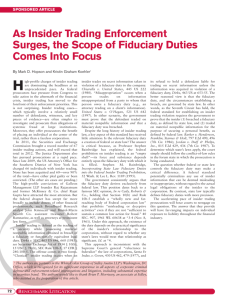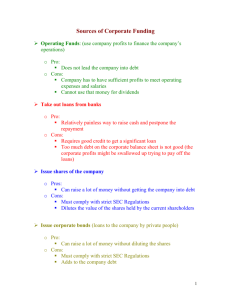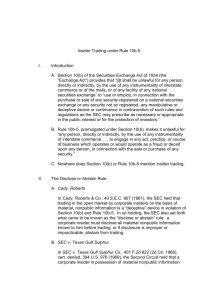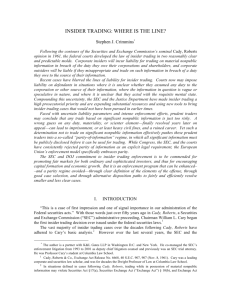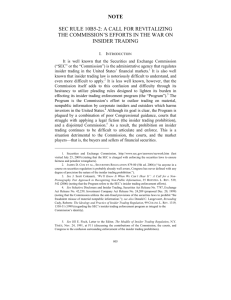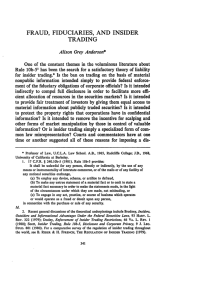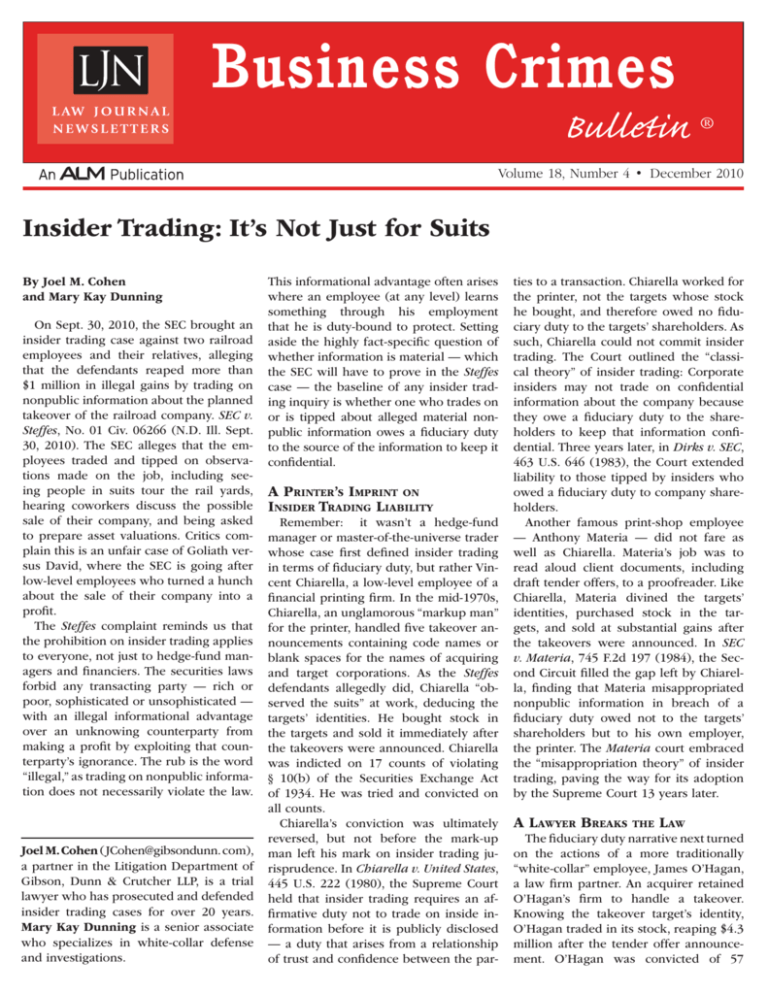
Business Crimes
Bulletin
®
Volume 18, Number 4 • December 2010
Insider Trading: It’s Not Just for Suits
By Joel M. Cohen
and Mary Kay Dunning
On Sept. 30, 2010, the SEC brought an
insider trading case against two railroad
employees and their relatives, alleging
that the defendants reaped more than
$1 million in illegal gains by trading on
nonpublic information about the planned
takeover of the railroad company. SEC v.
Steffes, No. 01 Civ. 06266 (N.D. Ill. Sept.
30, 2010). The SEC alleges that the employees traded and tipped on observations made on the job, including seeing people in suits tour the rail yards,
hearing coworkers discuss the possible
sale of their company, and being asked
to prepare asset valuations. Critics complain this is an unfair case of Goliath versus David, where the SEC is going after
low-level employees who turned a hunch
about the sale of their company into a
profit.
The Steffes complaint reminds us that
the prohibition on insider trading applies
to everyone, not just to hedge-fund managers and financiers. The securities laws
forbid any transacting party — rich or
poor, sophisticated or unsophisticated —
with an illegal informational advantage
over an unknowing counterparty from
making a profit by exploiting that counterparty’s ignorance. The rub is the word
“illegal,” as trading on nonpublic information does not necessarily violate the law.
Joel M. Cohen (JCohen@gibsondunn. com),
a partner in the Litigation Department of
Gibson, Dunn & Crutcher LLP, is a trial
lawyer who has prosecuted and defended
insider trading cases for over 20 years.
Mary Kay Dunning is a senior associate
who specializes in white-collar defense
and investigations.
This informational advantage often arises
where an employee (at any level) learns
something through his employment
that he is duty-bound to protect. Setting
aside the highly fact-specific question of
whether information is material — which
the SEC will have to prove in the Steffes
case — the baseline of any insider trading inquiry is whether one who trades on
or is tipped about alleged material nonpublic information owes a fiduciary duty
to the source of the information to keep it
confidential.
A Printer’s Imprint on
Insider Trading Liability
Remember: it wasn’t a hedge-fund
manager or master-of-the-universe trader
whose case first defined insider trading
in terms of fiduciary duty, but rather Vincent Chiarella, a low-level employee of a
financial printing firm. In the mid-1970s,
Chiarella, an unglamorous “markup man”
for the printer, handled five takeover announcements containing code names or
blank spaces for the names of acquiring
and target corporations. As the Steffes
defendants allegedly did, Chiarella “observed the suits” at work, deducing the
targets’ identities. He bought stock in
the targets and sold it immediately after
the takeovers were announced. Chiarella
was indicted on 17 counts of violating
§ 10(b) of the Securities Exchange Act
of 1934. He was tried and convicted on
all counts.
Chiarella’s conviction was ultimately
reversed, but not before the mark-up
man left his mark on insider trading jurisprudence. In Chiarella v. United States,
445 U.S. 222 (1980), the Supreme Court
held that insider trading requires an affirmative duty not to trade on inside information before it is publicly disclosed
— a duty that arises from a relationship
of trust and confidence between the par-
ties to a transaction. Chiarella worked for
the printer, not the targets whose stock
he bought, and therefore owed no fiduciary duty to the targets’ shareholders. As
such, Chiarella could not commit insider
trading. The Court outlined the “classical theory” of insider trading: Corporate
insiders may not trade on confidential
information about the company because
they owe a fiduciary duty to the shareholders to keep that information confidential. Three years later, in Dirks v. SEC,
463 U.S. 646 (1983), the Court extended
liability to those tipped by insiders who
owed a fiduciary duty to company shareholders.
Another famous print-shop employee
— Anthony Materia — did not fare as
well as Chiarella. Materia’s job was to
read aloud client documents, including
draft tender offers, to a proofreader. Like
Chiarella, Materia divined the targets’
identities, purchased stock in the targets, and sold at substantial gains after
the takeovers were announced. In SEC
v. Materia, 745 F.2d 197 (1984), the Second Circuit filled the gap left by Chiarella, finding that Materia misappropriated
nonpublic information in breach of a
fiduciary duty owed not to the targets’
shareholders but to his own employer,
the printer. The Materia court embraced
the “misappropriation theory” of insider
trading, paving the way for its adoption
by the Supreme Court 13 years later.
A Lawyer Breaks
the
Law
The fiduciary duty narrative next turned
on the actions of a more traditionally
“white-collar” employee, James O’Hagan,
a law firm partner. An acquirer retained
O’Hagan’s firm to handle a takeover.
Knowing the takeover target’s identity,
O’Hagan traded in its stock, reaping $4.3
million after the tender offer announcement. O’Hagan was convicted of 57
LJN’s Business Crimes Bulletin
counts of securities fraud, mail fraud, and
money laundering, and sentenced to 41
months in prison, but not before the lawyer made an impact on the fiduciary-duty
requirement. In United States v. O’Hagan,
521 U.S. 642 (1997), the Supreme Court
endorsed the misappropriation theory,
establishing liability for corporate outsiders who misappropriate, and then trade
on, inside information in violation of a
fiduciary duty owed to the information
source, such as an employer.
Are the Railroad Employees
Being Railroaded?
The Steffes case has prompted some to
wonder whether the railroad employees
occupied positions high enough within the
organization to possess material nonpublic
information, or whether they simply traded on a hunch that turned out to be right.
Defendant Gary Griffiths worked in a rail
yard as a vice president and mechanical
engineer of a subsidiary of Florida East
Coast Industries, Inc. (“FECI”), and his
nephew, defendant Cliff Steffes, worked
as a trainman in another rail yard. Both
defendants allegedly signed FECI’s Code
of Conduct prohibiting them from trading or tipping in FECI securities if they
possessed material nonpublic information about FECI, including merger or acquisition information.
According to the SEC, once FECI put itself in play, several bidders met with FECI
management and toured FECI properties,
including the rail yards where Griffiths
and Steffes worked. The SEC claims Griffiths knew about the sale because the
CFO asked him for asset valuations, he
noticed an unusually high number of rail
yard tours, and employees questioned
him about a possible takeover. Likewise,
Steffes noticed an uptick in tours by people in business attire, and his co-workers
were discussing the possible sale.
Steffes allegedly purchased FECI call
option contracts in an amount equal to
his net worth and sold them after the
takeover announcement, making a 350%
profit. Steffes and Griffiths also allegedly
tipped Steffes’s father, brothers, and another uncle, who settled with the SEC at
the end of October for $225,000. Collectively, the tippees netted more than $1
million in gains.
December 2010
Has the SEC Gone
Off the Tracks?
Some commentators suggest it is unfair
to punish these employees for being observant on the job, putting two and two
together, and happening to be right. Others wonder how they could access material nonpublic information in the first place,
since they didn’t work in management, finance, or other departments that routinely
receive confidential information. Of course,
what they knew goes to the issue of materiality, and it will be worth keeping a close
eye on this case to see whether the SEC can
adduce enough evidence of materiality.
What’s gotten lost in the outrage over
this case is that the duty allegations break
no new ground. The defendants allegedly signed codes of conduct, vowing to
preserve the confidentiality of information learned during their employment
and uphold their fiduciary duties to FECI
shareholders. Through their jobs, they allegedly gained an informational advantage over other shareholders and used
it to their benefit when they traded and
tipped. Whether they actually knew anything material about the takeover is another story, to be proven by the SEC.
The duty requirement gives structure to
the insider trading offense, which is not
defined by statute and developed only
through case law. The Supreme Court decided 30 years ago to frame the offense
in terms of fiduciary duty, which is one
of the only bright lines left in the offense.
The Court twice rejected the argument
that all market participants must have
equal access to information, reaffirming
each time that a fiduciary duty — plus a
corresponding breach — gives rise to liability. In recent years, however, the case
law has strayed from the fiduciary-duty
requirement and toward a general duty
to refrain from trading while possessing
any kind of material nonpublic information, despite Supreme Court guidance to
the contrary. Two recent high-profile cases demonstrate this. The Second Circuit
in SEC v. Dorozhko, 574 F.3d 42 (2d Cir.
2009), ruled that a computer hacker who
traded on inside information illegally obtained over the Internet was liable even
though he had no relation — fiduciary or
otherwise — with anyone having an interest in the stock. The Fifth Circuit recently
posited in SEC v. Cuban, 620 F.3d 551 (5th
Cir. 2010), that an agreement not to trade
might satisfy the duty requirement so that
a traditional fiduciary duty may no longer
be required. Does this mean that breach of
contract could become a crime?
Back
to
Basics
Unlike Dorozhko and Cuban, the Steffes
case represents insider trading’s return to
its roots. The fact pattern evokes Vincent
Chiarella in his print shop connecting the
dots and trading ahead of acquisition announcements. Whether the facts will develop as pled by the SEC remains to be
seen, but the fiduciary-duty allegations
seem solid.
The Steffes case reminds us that the
SEC must regulate all market activity
and investigate allegations of information misuse by anyone, whether he hails
from Wall Street or Main Street. For those
who follow insider trading jurisprudence
closely, Steffes is business as usual.
Reprinted with permission from the December 2010 edition of
the Law Journal Newsletters. © 2010 ALM Media
Properties, LLC. All rights reserved. Further duplication without
permission is prohibited. For information, contact 877.257.3382
or reprints@alm.com. #055081-12-10-02

